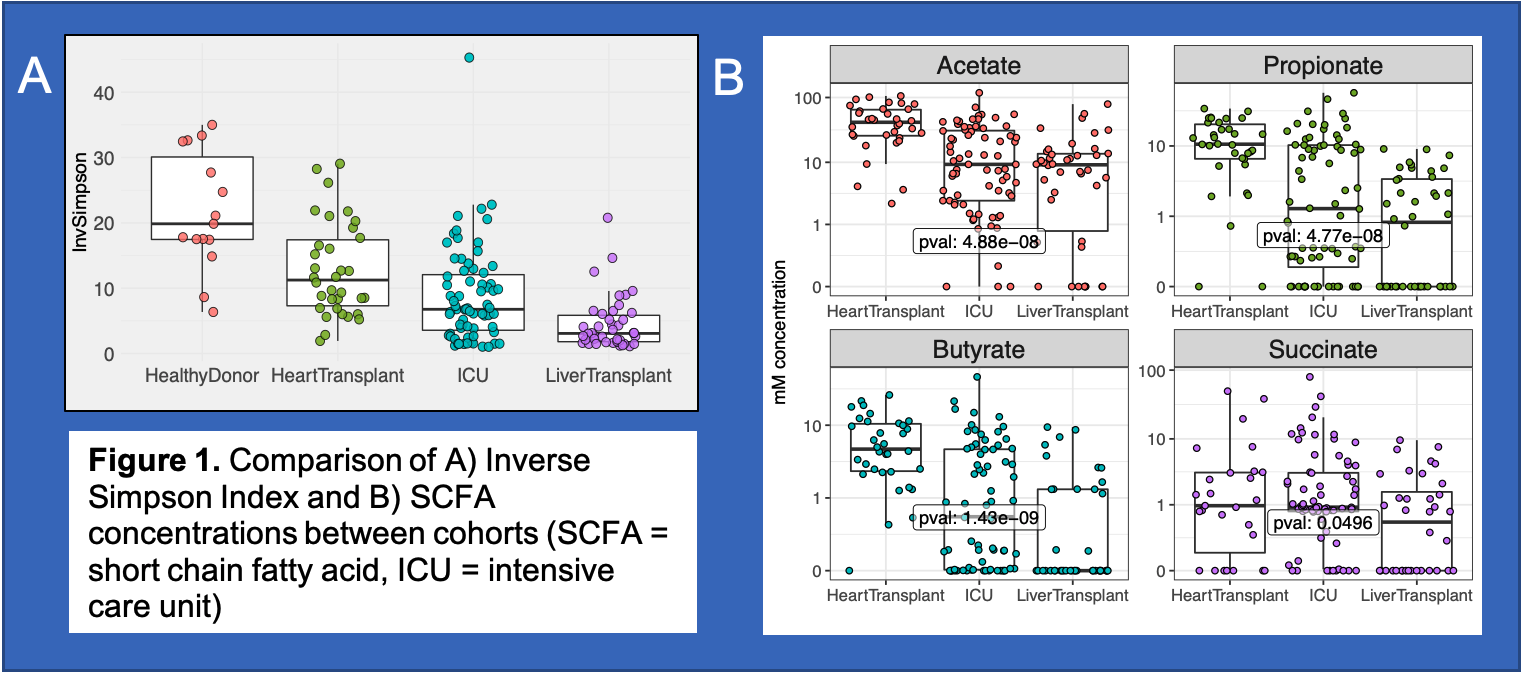The Gut Microbiome in Heart Transplantation: A Prospective Pilot Study
1Cardiology, University of Chicago, Chicago, IL, 2Medicine, University of Chicago, Chicago, IL, 3Surgery, University of Chicago, Chicago, IL
Meeting: 2021 American Transplant Congress
Abstract number: 17
Keywords: Heart, Heart transplant patients, Liver transplantation
Topic: Clinical Science » Biomarkers, Immune Assessment and Clinical Outcomes
Session Information
Session Name: Biomarkers, Immune Assessment and Clinical Outcomes - I
Session Type: Rapid Fire Oral Abstract
Date: Saturday, June 5, 2021
Session Time: 4:30pm-5:30pm
 Presentation Time: 5:00pm-5:05pm
Presentation Time: 5:00pm-5:05pm
Location: Virtual
*Purpose: The contribution of the intestinal microbiome to alloimmunity in heart transplantation (HT) is unknown. We examined the fecal microbiota of HT recipients at the time of transplantation and characterized microbiota composition, diversity, and metabolite production.
*Methods: In a prospective, observational, pilot study, pre and post-HT stool samples were collected and microbiota composition determined by 16S ribosomal RNA gene sequencing. Fecal short chain fatty acid (SCFA) concentrations were determined using targeted metabolomics. HT samples were compared to those from healthy controls (HC), liver transplant (LT), and ICU patients.
*Results: Fecal samples were analyzed from 15 HT recipients (including 2 heart-kidney, 1 heart-liver, 1 heart-liver-kidney) and compared to 15 HC, 16 LT, and 61 ICU patients. Within sample microbial diversity, quantified by inverse Simpson index, was lower in HT subjects compared to HC (p<0.002), but higher than that of ICU (p<0.003) and LT (p<0.001) (Fig.1A). HT microbiota had lower frequencies of Ruminococcaceae than HC (11.3% vs 24%, p<0.001), while ICU and LT had marked losses of obligate anaerobes and higher predominance of Enterococcus, Lactobacillus, and Proteobacteria. Compared to ICU and LT, HT microbiota had significantly higher abundances of the commensal anaerobic bacterial families Lachnospiraceae (HT 26.9% vs ICU 12.2% vs LT 4.8%, p<0.001) and Ruminococcaceae (HT 11.3% vs ICU 6.9% vs LT 1.2%, p<0.001), and higher butyrate concentrations (HT 7.06mM vs ICU 3.34mM vs LT 1.15mM, p<0.001) (Fig.1B). Among HT and ICU subjects, the presence of Lachnospiraceae strongly correlated with concentrations of the SCFAs acetate (r = 0.62, p<0.001), butyrate (r = 0.50, p<0.003), and propionate (r = 0.59, p<0.001). Similar correlations were seen with Ruminococcaceae. Analysis of beta diversity with Bray-Curtis and Unifrac PCoA demonstrated a trend towards clustering by cohort.
*Conclusions: The microbiota of HT recipients is less diverse than that of HC but is remarkably more diverse and contains a greater representation of commensal bacteria than that of LT or ICU subjects. SCFA concentrations differed significantly between cohorts and correlated with the presence of specific bacterial groups. Intriguing differences in microbiota composition and SCFA production are measurably identifiable between and within groups. Further recruitment, collection, and correlation to clinical outcomes is in progress.
To cite this abstract in AMA style:
Cruz MDela, Littmann E, Nayak R, Lehmann C, Keskey R, Baker T, Lin H, Bennett A, Kim G, Pinney S, Pamer E, Nguyen AB. The Gut Microbiome in Heart Transplantation: A Prospective Pilot Study [abstract]. Am J Transplant. 2021; 21 (suppl 3). https://atcmeetingabstracts.com/abstract/the-gut-microbiome-in-heart-transplantation-a-prospective-pilot-study/. Accessed December 20, 2025.« Back to 2021 American Transplant Congress

